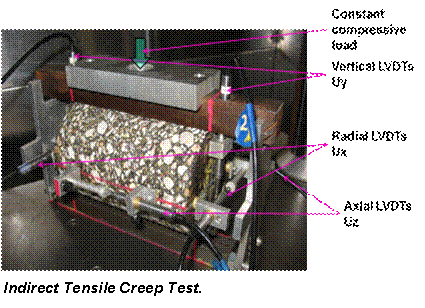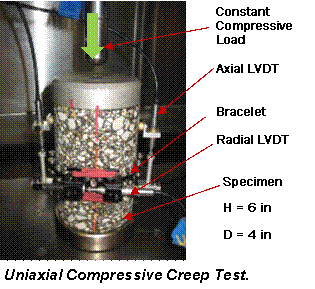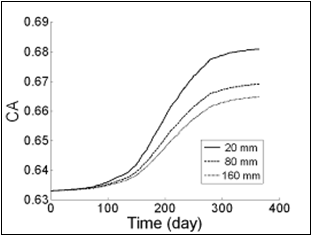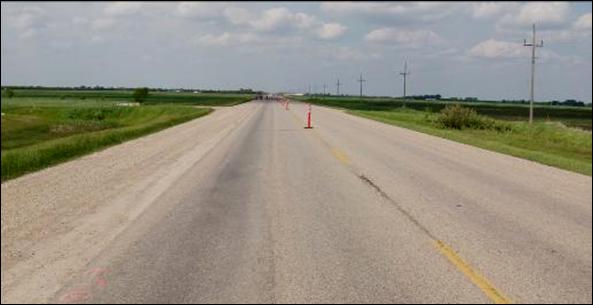|
ASPHALT RESEARCH CONSORTIUM |
|
An FHWA Research Program Comprising Western Research Institute, Texas A&M University, University of Wisconsin-Madison, University of Nevada-Reno and Advanced Asphalt Technologies. |
|
Asphalt Research Correspondent |
|
This issue highlights the work of Asphalt Research Consortium members Western Research Institute and Texas A&M University. Overall objectives, strategic plan, and work plans of the Asphalt Research Consortium are available on our website at: www.arc.unr.edu. |
|
Vol 3 Issue 1 Sept 2009 |
|
ARC research is giving hot mix asphalt designers the tools to predict and thus manage the future of their asphalt pavements. |
|
With the ability to see into the fundamental properties of hot mix asphalt components and mixtures, HMA designers can ensure a better future for HMA asphalt pavements. |
|
Successful Journey Ahead! New Methods + New Models by Texas A&M University Will Allow HMA Designers to Determine Undamaged Properties and Air Voids in HMA Pavements. For more information, see Work Element E1 of the ARC Quarterly Reports.
Undamaged Properties of Asphalt Mixtures in Tension & Compression
The Test Method Hot mix asphalt (HMA) pavements must withstand a variety of traffic and environmental stresses, including those from temperature and moisture. During the design process in the laboratory, trial asphalt mixtures are subjected to severe stress, temperature, and moisture conditions similar to those in the field. Measuring the damage requires knowing the undamaged properties of the asphalt mixture both in tension and compression. The most common summary expression of the undamaged properties of an asphalt mixture is its “master curve,” which shows the undamaged properties in a wide range of frequencies and temperatures. Until now, the testing to generate a master curve has been time-consuming and expensive. As one of the ARC work elements in the Engineered Materials program area, Texas A&M University has developed a new method to characterize the tension and compression properties of an undamaged mixture that can produce a master curve in only one day. The new method is simpler and more accurate than current methods and significantly reduces the technical effort required. ARC |






|
Undamaged Properties of Asphalt Components and Mixtures
The Mixture Model In the past, the design of hot mix asphalt mixtures has been characterized largely by trial and error. Now, Texas A&M has developed a model that lets the designer anticipate the undamaged properties of the mixture as a blend of the undamaged properties of its components. The mix components are the aggregate, binder (asphalt), fine particles imbedded in the binder, and air. The mixture model uses the principles of micromechanics to model the combined properties of the components. Dr. Robert Lytton of Texas A&M reports that the model has shed new light on the contribution of the aggregate to the properties of the mixture. The model will also predict the properties of an aged mixture on the basis of the aged binder. The model will allow mix designers to measure and catalogue the properties of the separate mixture components and streamline mixture design. Now, designers will be able to use the computer model to adjust the quantity of each component until the desired mixture properties are achieved. ARC
Air Void Size Distribution in Mixtures
The Method A key characteristic of a hot mix asphalt mixture is the size of its air voids. HMA mixtures with higher air void contents develop fatigue cracks earlier than those with lower air void contents. Mixtures with larger air voids age faster than those with smaller air voids. Aging occurs when air reacts with the asphalt to make it more brittle and more vulnerable to fatigue cracking. Predicting the effects of aging in HMA mixtures requires knowing the mean size of the air voids. As part of one of the ARC work elements in the Engineered Materials program area, Texas A&M has developed a new method to measure the quantity and mean size of air voids in a cross section of undamaged mixture and identify the distribution of the air void sizes. The new method also tracks the growth of the mean crack size as the air voids begin to grow under repeated loading. It has long been known that cracks in HMA pavement lead to a greater rate of aging. This new method provides a means for correlating aging with fatigue cracking. ARC
|
|
Predicting the effects of aging in HMA mixtures requires knowing the mean size of the air voids. (Being psychic doesn’t help.) |
|
Modeling gives mix designers an advantage over trial and error. |


|
Air Void Size Distribution to Predict Aging
The Oxidation Model ARC researchers at Texas A&M have developed a model to predict asphalt pavement aging in the field. The model requires the mean air void size and density in a typical cross-section of the asphalt pavement surface. It predicts the diffusion of air into the asphalt mixture and the reaction of the oxygen with the asphalt. The reaction rate depends on temperature and surface area in contact with the air. The higher the temperature, the faster the aging reaction. The ARC model predicts the temperature of the asphalt with depth below the surface and through long periods of day and night. The model is now being matched against field observations and tests on cores taken from pavements around the United States. Being able to anticipate how an asphalt will react and age before a pavement is constructed makes it possible to select better asphalts for specific projects and for longer service life. ARC
|
|
Calculated Carbonyl Area for Exxon AC-20 at Different Depths Below the Pavement Surface. For Temperature Profiles on SH-21 In Bryan, Texas, 1994.
|
|
|
|
Asphalts that react rapidly with oxygen may not be suitable for pavements exposed to high temperatures and abundant solar radiation. |

|
The chemo-mechanical modeling team of the Asphalt Research Consortium is working to realize the vision of a fundamental predictive model of asphalt concrete properties using a multiscale, multiphysics approach. The chemo-mechanical model will be valuable for predicting the performance of asphaltic materials in roadway construction applications and will have enormous importance to researchers, state DOTs, the paving industry, and others seeking to improve pavement performance. The model will cover the entire material system and account for fundamental chemistry, physics, and mechanics of the asphalt binder molecular composition interacting with the aggregate mineralogy. Experimental evidence indicates that asphalt binders, which are composed of complex petrol-organic molecules, are capable of dynamic structural changes, including phase separation, flocculation, crystallization, and melting. The modeling team includes researchers from Western Research Institute (WRI), the University of Rhode Island and Virginia Polytechnic University and is directed by Troy Pauli of WRI. The University of Rhode lsland (URI) team, led by Dr. Michael Greenfield, is conducting molecular dynamics simulations of model asphalt molecules. The results of the molecular dynamic simulations will be scaled up and used as inputs to the phase field models operating at increased length and time scales. The main challenge will be to accomplish this in a way that can be seamlessly integrated into a multiscale approach and keep the model flexible enough to handle a variety of boundary conditions and statistical mechanical conditions, while retaining chemical flexibility and accuracy at the input. The research activities at Virginia Polytechnic University (Virginia Tech) are being led by Dr. Linbing Wang. The Virginia Tech team is analyzing the physical properties of asphalt through molecular simulation (in collaboration with URI and WRI) by using reasonably accurate modeling of asphalt mixture compositions with different compounds of the constituents (asphaltene, maltene, and resin). The Virginia Tech team is also investigating the asphalt–aggregate interface using simulations of the interface properties under different loading conditions and temperatures. Although tremendous research efforts have been devoted to investigating fatigue behavior of asphalt concrete, understanding fatigue at microscopic and nano scale is limited. Fatigue life of a specimen is currently determined at 50% reduction of the modulus. A scientific basis is needed for better understanding the fatigue and healing mechanism. Virginia Tech’s nano-scale simulations of asphalt-aggregate mixtures will be aimed at understanding the mechanism of fatigue and healing and the influence of moisture. ARC
|
|
WRI is joined by new ARC Partners for on an ambitious predictive model of material properties using a chemo-mechanical approach |





|
The ARC and Manitoba Infrastructure & Transportation are preparing to construct two new comparative pavement performance sites in Manitoba, Canada. |
|
New Manitoba pavement sites will give the ARC an unprecedented look at recycled and warm-mix asphalt performance |
|
To remove your name from our mailing list, please click here. Questions or comments? E-mail us at psebaaly@unr.edu or call 775-784-6565. |